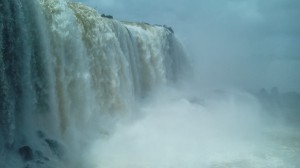 La realta' e' che si sono formate a causa dell'ira di un dio della foresta, ilquale molto geloso vide un guerriero Guarani' che scappava con una bella fanciulla su di una canoa, navigando il fiume Iguazu. Oltragiato e ferito decise di creare un cratere davanti ai due amanti, producendo una cascata imponente di 82 metri, dove la ragazza cadde trasformandosi in roccia ai suoi piedi, mentre lui sopravvisse come pianta al ciglio del precipizio... vedendo ogni giorno il suo amore 'caduto'.
Pura realta' Guarani'.
La realta' e' che si sono formate a causa dell'ira di un dio della foresta, ilquale molto geloso vide un guerriero Guarani' che scappava con una bella fanciulla su di una canoa, navigando il fiume Iguazu. Oltragiato e ferito decise di creare un cratere davanti ai due amanti, producendo una cascata imponente di 82 metri, dove la ragazza cadde trasformandosi in roccia ai suoi piedi, mentre lui sopravvisse come pianta al ciglio del precipizio... vedendo ogni giorno il suo amore 'caduto'.
Pura realta' Guarani'.
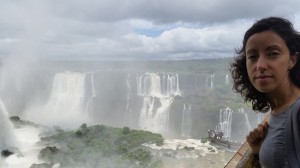 La parte curiosa delle cascate e' la posizione, infatti si trovano al confine tra Argentina, Brasile e Paraguay, nel parco nazionale diviso anch'esso. Tutta l'area ovviamente e' protetta e con entrata a pagamento – precisamente 220pesos per la parte argentina e circa il doppio per il lato brasiliano. Questa cosa fa ridere in quanto la parte piu grande con percorsi ed attivita' e' quella bianco-celeste, mentre i brasiliani hanno un lembo di terra con un solo, e anche piccolo, percorso e un paio di cosette finte come il climbing a parete artificiale, pero' la visuale piu bella e' la loro con tanto di passerella che permette la passeggiata sulle cascate 'alla Jesus': si cammina sull'acqua delle cascate fino ad arrivare al precipizio. Ai brasileiri gli e' andata meglio!
C'e' da dire inoltre che la parte del parco brasiliano e' molto ben tenuta ed ordinata. Forse perche' e' piu piccola, forse perche' hanno piu soldi.. non so ma la differenza c'e'.
La parte curiosa delle cascate e' la posizione, infatti si trovano al confine tra Argentina, Brasile e Paraguay, nel parco nazionale diviso anch'esso. Tutta l'area ovviamente e' protetta e con entrata a pagamento – precisamente 220pesos per la parte argentina e circa il doppio per il lato brasiliano. Questa cosa fa ridere in quanto la parte piu grande con percorsi ed attivita' e' quella bianco-celeste, mentre i brasiliani hanno un lembo di terra con un solo, e anche piccolo, percorso e un paio di cosette finte come il climbing a parete artificiale, pero' la visuale piu bella e' la loro con tanto di passerella che permette la passeggiata sulle cascate 'alla Jesus': si cammina sull'acqua delle cascate fino ad arrivare al precipizio. Ai brasileiri gli e' andata meglio!
C'e' da dire inoltre che la parte del parco brasiliano e' molto ben tenuta ed ordinata. Forse perche' e' piu piccola, forse perche' hanno piu soldi.. non so ma la differenza c'e'.
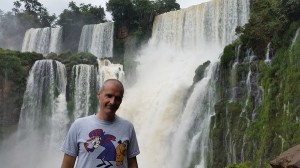 Il lato argentino si fa con un giorno ma anche due, infatti se uno si organizza bene si fa timbrare il biglietto all'entrata per avere accesso al parco il secondo giorno a meta' prezzo. Qui ci sono percorsi accessibili a tutti: dal piccolino 'Verde', ai piu battuti 'Superiore' e 'Inferiore', passando per il 'Macuco' piu impegnativo (tre ore di cammino nella foresta per arrivare ad una cascata nascosta dove ci si puo fare il bagno). Oltre a questi percorsi inclusi nel prezzo d'entrata, il parco organizza delle 'avventure', tipo un giro su di un 4x4, rafting e una bella doccia sotto la due cascate piu grandi: salto Bosetti e la garganta del diablo. Noi abbiamo deciso per la 'Gran Avventura' che comprendeva la passeggiata in jeep nella foresta e il giro in barca nel fiume tra le correnti, incluso il battesimo delle cascate: in pratica la barca diventa un biscottone che il 'barcadero' decide di inzuppare sotto l'acqua che viene giu dalle cascate. Divertente e un po cretino, ma piu divertente che cretino.
(Fortunatamente siamo stati previdenti da partire in costume e portarci il cambio.)
Il lato argentino si fa con un giorno ma anche due, infatti se uno si organizza bene si fa timbrare il biglietto all'entrata per avere accesso al parco il secondo giorno a meta' prezzo. Qui ci sono percorsi accessibili a tutti: dal piccolino 'Verde', ai piu battuti 'Superiore' e 'Inferiore', passando per il 'Macuco' piu impegnativo (tre ore di cammino nella foresta per arrivare ad una cascata nascosta dove ci si puo fare il bagno). Oltre a questi percorsi inclusi nel prezzo d'entrata, il parco organizza delle 'avventure', tipo un giro su di un 4x4, rafting e una bella doccia sotto la due cascate piu grandi: salto Bosetti e la garganta del diablo. Noi abbiamo deciso per la 'Gran Avventura' che comprendeva la passeggiata in jeep nella foresta e il giro in barca nel fiume tra le correnti, incluso il battesimo delle cascate: in pratica la barca diventa un biscottone che il 'barcadero' decide di inzuppare sotto l'acqua che viene giu dalle cascate. Divertente e un po cretino, ma piu divertente che cretino.
(Fortunatamente siamo stati previdenti da partire in costume e portarci il cambio.)
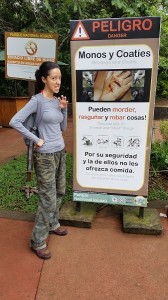 Il secondo giorno siamo andati al lato brasiliano, che e' un terzo del vicino di casa, ma molto piu scenico. Si fa in mezza giornata, dove si passa tutto il tempo a godere del panorama e fare foto, piuttosto che camminare.
In tutto questo c'e' una fauna impressionante: coati e scimmie ladroni ed aggressivi che riescono anche a frugare negli zaini in cerca di cibo, distribuendo graffi e morsi a chi glielo impedisce; tucani vanitosi che si mettono in posa per lo scatto migliore; farfalle, iguane, insetti e giaguari in via d'estinzione. Abbiamo incontrato tutto tranne i felini -per fortuna- che vivono protetti nel parco; di loro si nota la presenza per via delle tracce che lasciano, ma sono molto discreti e non si fanno vedere -sempre per fortuna.
La cittadina piu vicina alle cascate e' Puerto Iguazu che offre tutto quello che un turista desidera. Ma a parte suvenirs e ninnoli vari, qui c'e' il sito delle tre frontiere, dove il fiume Iguazu si unisce al Parana' per poi arrivare a Buenos Aires come fiume Plata. I fiumi dividono la terra disegnando una netta separazione tra i tre dirimpettai: Argentina, Brasile e Paraguay. FORTE!
Il secondo giorno siamo andati al lato brasiliano, che e' un terzo del vicino di casa, ma molto piu scenico. Si fa in mezza giornata, dove si passa tutto il tempo a godere del panorama e fare foto, piuttosto che camminare.
In tutto questo c'e' una fauna impressionante: coati e scimmie ladroni ed aggressivi che riescono anche a frugare negli zaini in cerca di cibo, distribuendo graffi e morsi a chi glielo impedisce; tucani vanitosi che si mettono in posa per lo scatto migliore; farfalle, iguane, insetti e giaguari in via d'estinzione. Abbiamo incontrato tutto tranne i felini -per fortuna- che vivono protetti nel parco; di loro si nota la presenza per via delle tracce che lasciano, ma sono molto discreti e non si fanno vedere -sempre per fortuna.
La cittadina piu vicina alle cascate e' Puerto Iguazu che offre tutto quello che un turista desidera. Ma a parte suvenirs e ninnoli vari, qui c'e' il sito delle tre frontiere, dove il fiume Iguazu si unisce al Parana' per poi arrivare a Buenos Aires come fiume Plata. I fiumi dividono la terra disegnando una netta separazione tra i tre dirimpettai: Argentina, Brasile e Paraguay. FORTE!
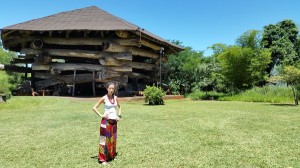 Per una mezza giornata libera abbiamo deciso, dopo un bagno in piscina, di visitare il centro Guarani chiamato 'La Aripuca'. Questo e' stato creato e messo su per preservare e promuovere la cultura Guarani, popolazione indigena che abita in questa regione (oltre che Brasile, Paraguay e parte in Bolivia). Il centro e' molto bello in quanto hanno ricostruito in forma XXL la trappola che utilizzavano per catturare gli animali di piccola taglia; da qui il nome aripuca che significa trappola. Qui e' costruito tutto in legno, come anche tre capanne dove si possono vedere prodotti di artigianato e manifattura Guarani', un chiosco e un ristorante.
Fondalmente il centro e' un progetto di riforestazione, che avviene di generazione in generazione; l'idea e' che gli alberi vengono presi in custodia da una famiglia che li 'possiede' per generazioni intere, dando loro la possibilita' di crescere. Un albero per diventare 'adulto' deve raggiungere i 100 anni, e per far passare il messaggio hanno creato un entrata importante e degna di rispetto: la porta consiste in due alberi disposti ai lati di rispettivamente 1000 e 500 anni. Anche se misura su altezza di almeno sei metri, bisognerebbe inchinarsi nel passare.
Per una mezza giornata libera abbiamo deciso, dopo un bagno in piscina, di visitare il centro Guarani chiamato 'La Aripuca'. Questo e' stato creato e messo su per preservare e promuovere la cultura Guarani, popolazione indigena che abita in questa regione (oltre che Brasile, Paraguay e parte in Bolivia). Il centro e' molto bello in quanto hanno ricostruito in forma XXL la trappola che utilizzavano per catturare gli animali di piccola taglia; da qui il nome aripuca che significa trappola. Qui e' costruito tutto in legno, come anche tre capanne dove si possono vedere prodotti di artigianato e manifattura Guarani', un chiosco e un ristorante.
Fondalmente il centro e' un progetto di riforestazione, che avviene di generazione in generazione; l'idea e' che gli alberi vengono presi in custodia da una famiglia che li 'possiede' per generazioni intere, dando loro la possibilita' di crescere. Un albero per diventare 'adulto' deve raggiungere i 100 anni, e per far passare il messaggio hanno creato un entrata importante e degna di rispetto: la porta consiste in due alberi disposti ai lati di rispettivamente 1000 e 500 anni. Anche se misura su altezza di almeno sei metri, bisognerebbe inchinarsi nel passare.
Iguazu Waterfalls
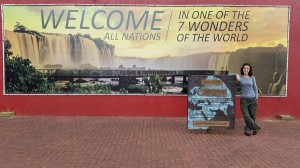 Practically one of the seven wonders of the world.
Artificially created by the local community of the Mission region a few years ago; today they show a series of video installations projected on water and organise festivals organized by the local Guarani.
Just kidding, that is very far from reality.
The reality is that they formed due to god's anger of the forest , who was very jealous. When he saw a Guarani warrior escaping with a beautiful girl on a canoe, navigating the Iguazu River, he decided to create a crater in front of the lovers, producing an impressive waterfall of 82 metres. Here the girl fell and became a rock at the foot of the waterfall, while he survived as a plant at the edge of the river... seeing his 'fallen' love every day.
Real story of 'Guarani'.
Practically one of the seven wonders of the world.
Artificially created by the local community of the Mission region a few years ago; today they show a series of video installations projected on water and organise festivals organized by the local Guarani.
Just kidding, that is very far from reality.
The reality is that they formed due to god's anger of the forest , who was very jealous. When he saw a Guarani warrior escaping with a beautiful girl on a canoe, navigating the Iguazu River, he decided to create a crater in front of the lovers, producing an impressive waterfall of 82 metres. Here the girl fell and became a rock at the foot of the waterfall, while he survived as a plant at the edge of the river... seeing his 'fallen' love every day.
Real story of 'Guarani'.
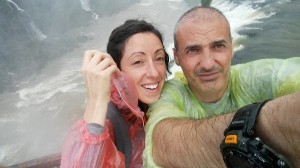 The curious part of the waterfalls is their position; in fact, they are located on the borders between Argentina, Brazil and Paraguay, in the national park which is also shared by the three. Of course, the whole area is protected and requires entry tickets - precisely 220pesos for the Argentine side and about double that for the Brazilian side. This makes me laugh because the biggest part is the blue and white with trails and activities, while the Brazilians have a strip of land with a single, small, path and a few fake things like an artificial wall for climbing. However, the most beautiful view is on this side, which has a wooden catwalk that allows you to walk over the falls 'Jesus' style: walking on the water of the waterfalls up right to the precipice. The Brazilians got the better end of the stick!
The curious part of the waterfalls is their position; in fact, they are located on the borders between Argentina, Brazil and Paraguay, in the national park which is also shared by the three. Of course, the whole area is protected and requires entry tickets - precisely 220pesos for the Argentine side and about double that for the Brazilian side. This makes me laugh because the biggest part is the blue and white with trails and activities, while the Brazilians have a strip of land with a single, small, path and a few fake things like an artificial wall for climbing. However, the most beautiful view is on this side, which has a wooden catwalk that allows you to walk over the falls 'Jesus' style: walking on the water of the waterfalls up right to the precipice. The Brazilians got the better end of the stick!
 It needs to be said that the Brazilian side of the park is very well kept and tidy. Maybe because it's smaller, maybe because they have more money .. maybe... I don’t know but there is a big difference.
The Argentine side can be done in a day but it’s better to do it in two, in fact the ticket can be stamped at the entrance to gain access to the park on the second day for half price. There are routes that are accessible for all: the little one 'Green', the most beaten 'Upper' and 'Lower', through to the most challenging 'Macuco' (three hours of walking in the forest to get to a hidden waterfall where you can swim). Besides these paths and also included in the entrance fee, the park organises 'adventures', like a ride on a 4x4, rafting and a nice shower in the two more powerful waterfalls: Salto Bosetti and the Throat of the Devil (la garganta del diablo). We decided on the 'Great Adventure' which included a jeep ride in the forest and a boat ride in the river between the currents. It included the 'baptism' of the waterfalls: basically the boat becomes a big cookie that the steersman decides to dip into the water, coming down from the falls. Fun and a bit stupid, but more fun than stupid.
(Fortunately we were wise - wearing swimming costumes and we brought dry clothes with us.)
It needs to be said that the Brazilian side of the park is very well kept and tidy. Maybe because it's smaller, maybe because they have more money .. maybe... I don’t know but there is a big difference.
The Argentine side can be done in a day but it’s better to do it in two, in fact the ticket can be stamped at the entrance to gain access to the park on the second day for half price. There are routes that are accessible for all: the little one 'Green', the most beaten 'Upper' and 'Lower', through to the most challenging 'Macuco' (three hours of walking in the forest to get to a hidden waterfall where you can swim). Besides these paths and also included in the entrance fee, the park organises 'adventures', like a ride on a 4x4, rafting and a nice shower in the two more powerful waterfalls: Salto Bosetti and the Throat of the Devil (la garganta del diablo). We decided on the 'Great Adventure' which included a jeep ride in the forest and a boat ride in the river between the currents. It included the 'baptism' of the waterfalls: basically the boat becomes a big cookie that the steersman decides to dip into the water, coming down from the falls. Fun and a bit stupid, but more fun than stupid.
(Fortunately we were wise - wearing swimming costumes and we brought dry clothes with us.)
 The second day we went to the Brazilian side, which is one third of the neighbouring countries, but much more scenic. This part can be done in half a day, where one can spend all their time enjoying the view and taking pictures, rather than walking.
In the park, there is an impressive fauna: coatis and monkeys – little aggressive thieves that can easily nuzzle in people's backpacks in search of food, distributing scratches and bites to those who would prevent them achieving their goal; vain toucans that pose for their best angle; butterflies, iguanas, insects and endangered jaguars. We met all of them but the cats, luckily, as they are protected in the park: traces of them can be found and seen, but they are very discreet and do not show themselves - luckily.
The second day we went to the Brazilian side, which is one third of the neighbouring countries, but much more scenic. This part can be done in half a day, where one can spend all their time enjoying the view and taking pictures, rather than walking.
In the park, there is an impressive fauna: coatis and monkeys – little aggressive thieves that can easily nuzzle in people's backpacks in search of food, distributing scratches and bites to those who would prevent them achieving their goal; vain toucans that pose for their best angle; butterflies, iguanas, insects and endangered jaguars. We met all of them but the cats, luckily, as they are protected in the park: traces of them can be found and seen, but they are very discreet and do not show themselves - luckily.
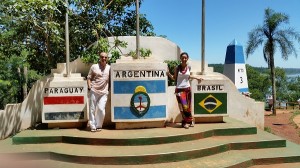 The closest town to the waterfalls is Puerto Iguazu, which offers everything a tourist wants. But apart from souvenirs and various trinkets, it’s the site of the three borders, where the Iguazu River joins the Parana and, then, gets to Buenos Aires as River Plata. The rivers divide the land by drawing a clear distinction between the three neighbours: Argentina, Brazil and Paraguay. COOL!
The closest town to the waterfalls is Puerto Iguazu, which offers everything a tourist wants. But apart from souvenirs and various trinkets, it’s the site of the three borders, where the Iguazu River joins the Parana and, then, gets to Buenos Aires as River Plata. The rivers divide the land by drawing a clear distinction between the three neighbours: Argentina, Brazil and Paraguay. COOL!
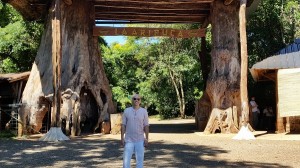 For a free half day we decided, after a swim in the pool, to visit the Guarani centre called 'La Aripuca'. This was created to preserve and promote the Guarani culture of the indigenous people that live in this region (as well as Brazil, Paraguay and part of Bolivia). The center is very nice as they have reconstructed, in XXL size, the trap they used to use to catch small animals; hence the name Aripuca which means ‘trap’. Here everything is built entirely of wood, as well there are three huts where you can see handicrafts and Guarani's manufacturing, a kiosk and a restaurant.
For a free half day we decided, after a swim in the pool, to visit the Guarani centre called 'La Aripuca'. This was created to preserve and promote the Guarani culture of the indigenous people that live in this region (as well as Brazil, Paraguay and part of Bolivia). The center is very nice as they have reconstructed, in XXL size, the trap they used to use to catch small animals; hence the name Aripuca which means ‘trap’. Here everything is built entirely of wood, as well there are three huts where you can see handicrafts and Guarani's manufacturing, a kiosk and a restaurant.
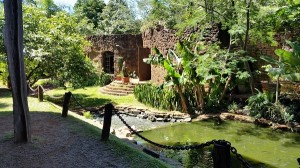 Fundamentally the center is a project for reforestation, which takes place from generation to generation: the idea is that the trees are taken into custody by a family that owns them for generations, which gives the trees the opportunity to grow. For a tree to become an 'adult' it needs to be 100 years old, so to pass on this message they created an important entry, worthy of respect: the door has two trees on either side of it, which are 1000 and 500 years old. Although the tree is at least six meters high, everybody should kneel in passing.
Fundamentally the center is a project for reforestation, which takes place from generation to generation: the idea is that the trees are taken into custody by a family that owns them for generations, which gives the trees the opportunity to grow. For a tree to become an 'adult' it needs to be 100 years old, so to pass on this message they created an important entry, worthy of respect: the door has two trees on either side of it, which are 1000 and 500 years old. Although the tree is at least six meters high, everybody should kneel in passing. 